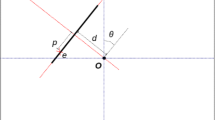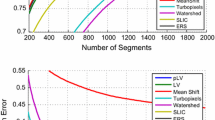Abstract
In this paper the problem of image feature extraction is considered with emphasis on developing methods which are resilient in the presence of data contamination. The issue of robustness of estimation procedures has received considerable attention in the statistics community [1–3] but its results are only recently being applied to specific image analysis tasks [4–7]. In this paper we show how the design of robust methods applies to image description tasks posed within a statistical hypothesis testing and parameter estimation framework. The methodology is illustrated by applying it to finding robust, optimal estimation kernels for line detection and edge detection. We then discuss the relationship of these optimal solutions to both the well established Hough Transform technique and the standard estimation kernels developed in the statistics literature. The application of standard robust kernels to image analysis tasks is illustrated by two examples which involve circular arc detection in gray-level imagery and planar surface segmentation in depth data. Robust methods are found to be effective general tools for generating 2D and 3D image descriptions.
Similar content being viewed by others
Explore related subjects
Discover the latest articles, news and stories from top researchers in related subjects.References
P.J. Huber, Robust estimation of a location parameter, Ann. Math. Stat. 35 (1964) 73–101.
F. Hampel, E. Ronchetti, P. Rousseeuw and W. Stahel,Robust Statistics: The Approach Based on Influence Functions, (Wiley, New York, 1986).
P.J. Rousseeuw and A.M. Leroy,Robust Regression & Outlier Rejection, (Wiley, New York, 1987).
J. Princen, Hough transform methods for curve detection and parameter estimation, Ph.D. Thesis, University of Surrey (1990).
P. Meer, Robustness by consensus: the least median of squares family of estimators, in:Esprit-90 Vision Workshop, Heraklion, Greece, September 1990.
P.J. Besl, J.B. Birch and L.T. Watson, Robust window operators, in:Proc. 2nd IEEE Int. Conf. on Computer Vision, Florida, December 1988, pp. 591–600.
M. Petrou and J. Kittler, A robust method for edge detection, in:Applications of Artificial Intelligence X: Machine Vision and Robotics, SPIE 1708 (1992) 267–281.
J. Canny, A computational approach to edge detection, IEEE Trans. on Pattern Analysis and Machine Intelligence 6(6) (1986) 679–698.
R. Deriche, Using Canny's criteria to derive a recursively implemented optimal edge detector,Int. J. Computer Vision 1(2) (1987) 167.
M. Petrou and J. Kittler, Optimal edge detectors for ramp edges, IEEE Trans. Pattern Analysis and Machine Intelligence 13 (1991) 483–491.
G.C. Stockman and A.K. Agrawala, Equivalence of Hough curve detection to template matching, Commun. ACM 20 (1977) 820–822.
G.A. Jones, J. Princen, J. Illingworth and J. Kittler, Robust estimation of shape parameters, in:Proc. British Machine Vision Conference, Oxford, UK, September 1990.
G.A. Jones, J. Princen, J. Illingworth and J. Kittler, Depth data segmentation using robust estimation in a hierarchical data structure, in:Proc. IAPR Int. Workshop on Visual Form, Capri, Italy, May 1991.
Author information
Authors and Affiliations
Rights and permissions
About this article
Cite this article
Illingworth, J., Jones, G., Kittler, J. et al. Robust statistical methods of 2D and 3D image description. Ann Math Artif Intell 10, 125–148 (1994). https://doi.org/10.1007/BF01530946
Issue Date:
DOI: https://doi.org/10.1007/BF01530946




